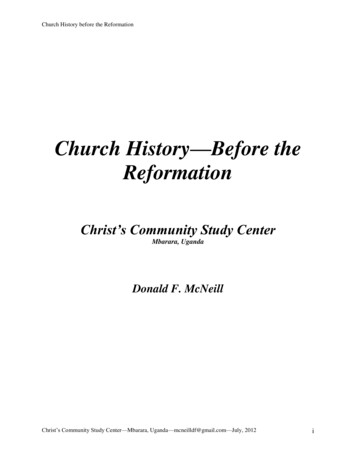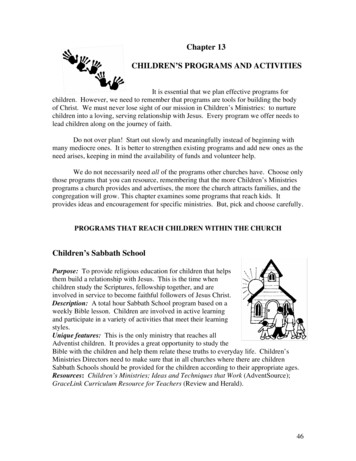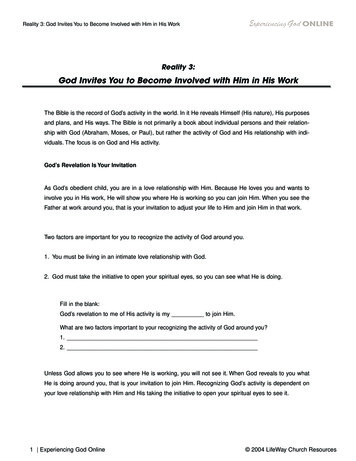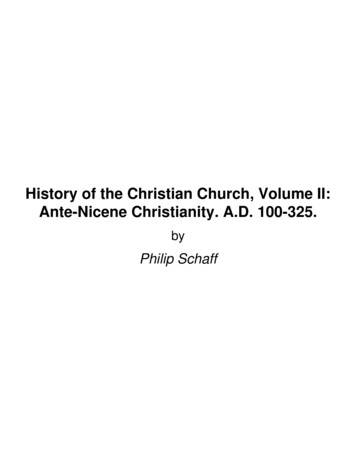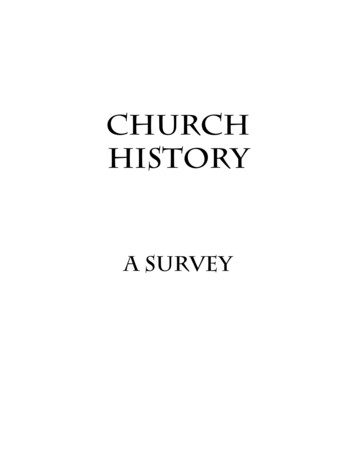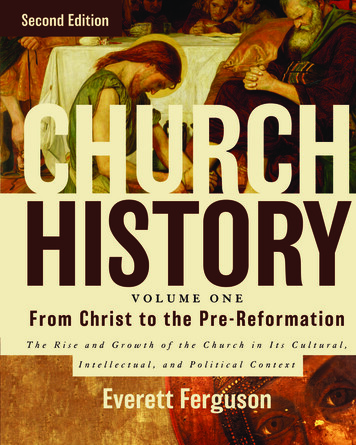
Transcription
Church History, Volume 1: From Christ to thePre-Reformation (2nd edition)By Everett FergusonThe Christian church spread and developed, not in a vacuum, but in asetting of times, cultures, and events that both influenced and wereinfluenced by the church.In Church History, Everett Fergusonexplores the development of thechurch from the days of Jesus tothe years prior to the Reformation.Filled with maps, charts, andillustrations, it offers overviews ofthe Roman, Greek, and Jewishworlds; insights into the church’srelationship to the Roman Empire, with glimpses into pagan attitudestoward Christians; the place of art and architecture, literature andphilosophy, both sacred and secular; and much more, spanning thetime from the first through the thirteenth centuries.Shop for the book today
1The Setting for the Story’s BeginningThree concentric circles of influence circumscribed the world inwhich early Christianity began. From the outside moving in, theseinfluences were the Roman, the Greek, and the Jewish. The pattern ofgrowth in the early church was the reverse, from the Jewish, to theGreek, to the Roman worlds. Unlike the mathematical image, however,these worlds were not sharply differentiated from each other, and theboundaries were quite porous.Nevertheless, the classification of influences ishelpful in grasping the environment in which the earlychurch began. Moreover, these influences remainedformative for much of subsequent Christian history.“When the timehad fully come,God sent hisSon, born of awoman, bornunder law”(Galatians 4:4).I. THE ROMAN WORLDLuke sets the story of Jesus and the early churchfirmly within Roman history, noting Jesus’ birth underthe emperor Augustus, his ministry under Tiberius, andmentioning the Roman governors and other officialswith whom Jesus and later Paul had encounters (Luke2:1 – 2; 3:1; Acts 13:7; 18:12; 24:27). Rome providedthe larger governmental, military, and legal context ofearly Christianity.At the birth of Jesus, Rome had recently completedthe transition from the Republic to the imperial Principate under Augustus (27 BC – AD 14). Not long beforethat, the Roman general Pompey had conquered Palestine in 63 BC, and thereafter Rome ruled the Jewishhomeland, alternating various administrative arrangements through which it exercised its will: legates basedin Syria; client kings like Herod the Great, during whose rule Jesuswas born; and governors like Pontius Pilate, under whom Jesus wascrucified.Emperor Augustus,portrayed as a god(ArchaeologicalMuseum, Thessalonica, Greece).279780310516569 ChurchHist-Vol1 2e int CS6.indd 279/18/13 2:25 PM
28CHURCH HISTORYChapter 1Emperor Tiberius,from Paestum(ArchaeologicalMuseum, Madrid).The Setting for the Story’s BeginningThe organization of the empire seems to have provided a patternfor the eventual development of the church’s hierarchy, and procedures in the senate at Rome and at city councils influenced the conduct of church synods.The army — the legions made up of Roman citizensand the auxiliaries composed of native peoples — wasa constant presence on the frontiers and in provinceswhere disturbances were frequent. Among the peacetime duties of soldiers were the building of roads andsecuring safety of travel; Christian travelers, whetherfor business or religious purposes, used these roads andcarried the Christian message with them.Roman law is one of Rome’s enduring legaciesto the Western world. When charges were broughtagainst Christians, Roman magistrates and Roman lawdecided their cases. The imperial cult (the giving ofdivine honors to the emperor and his family), oftenallied with the local civic cults, provided an overarching religious cement to political unity and loyalty. Theimperial court ceremonials, themselves borrowed fromearlier eastern monarchs, continued under later Christian emperors.Latin not only was the official language of government, but also became the common language in the western provinces; from the second century and after, Christianity in those regionsexpressed its message in Latin.II. THE GREEK WORLDGreek influences were predominant in language, education, literature, and philosophy at the beginning of Christianity. For the earlydisciples, the Greek language and culture were more significant thanthe Latin, and they remained so for the eastern Mediterranean areaunder the Byzantine empire (even though Latin remained its officiallanguage of government for centuries). Since the conquests of Alexander the Great in the fourth century BC, the Greek language, coinage, culture, philosophy, and religion had permeated the regions fromGreece around the eastern coast of the Mediterranean to Libya. Education was based on Homer and the Greek classics.The Greek cultural influences were felt in Rome and regions tothe west, even among those who did not speak Greek. Greek was thelanguage of the church in Rome, it seems, until the middle of the thirdcentury. Christian writers employed the Greek language exclusively,9780310516569 ChurchHist-Vol1 2e int CS6.indd 289/18/13 2:25 PM
The Setting for the Story’s Beginningit appears, until the late second century, when some works in Latinand Syriac are known. Greek (and then Latin) rhetoric provided thestandards for how letters were written, speeches constructed, and arguments conducted.The great philosophical systems of Plato andAristotle had been largely replaced in the Hellenisticage by philosophies more directed to practical andmoral interests, principally Stoicism and Epicureanism, but interest in Aristotle and especially Platorevived in the early Christian centuries. As Christian theology developed from the affirmations of thegospel and the early moral and doctrinal instruction, Greek philosophy provided the vocabulary,ethical assumptions, thought world, and intellectualoptions with which Christian thinkers worked.The traditional civic cults continued to beimportant centers of local pride, and traditional religious attitudes and practices continued to be nourished by the educational curriculum that centeredon Homer. Initiations into mystery religions, visitsto oracles and healing shrines, acceptance of fate,belief in astrology, and the practice of magic gainednew strength during the first two centuries of theChristian era.The social lives of people were guided by a combination of Romanlegal and Greek societal norms. Thus in matters as varied as customsat dinner parties, at weddings, and at funerals, Christians lived withinthe framework of existing ways of doing things. Laws of marriage andof inheritance and established distinctions of social classes provided theframework for family life and social relations.Pre-existing mentalities shaped religious attitudes. Funerary customs continued to be observed by Christians, although now within anew frame of reference. Many of the features of Greco-Roman religionbecame incorporated into Christianity as the gospel spread into thepagan population.29CHURCH HISTORYChapter 1Unidentified Greekphilosopher of thesecond century AD(Delphi Museum,Greece).III. THE JEWISH WORLDJesus was born of Jewish parents, “the son of David, the son ofAbraham” (Matthew 1:1), and all his first disciples were Jewish. Jesuswas born in Bethlehem and grew up in Nazareth; most of his ministrywas in Galilee, and he was crucified in Jerusalem — all places in modern Israel and the adjoining Palestinian territories.9780310516569 ChurchHist-Vol1 2e int CS6.indd 299/18/13 2:25 PM
Church History, Volume 1: From Christ to thePre-Reformation (2nd edition)By Everett FergusonThe Christian church spread and developed, not in a vacuum, but in asetting of times, cultures, and events that both influenced and wereinfluenced by the church.In Church History, Everett Fergusonexplores the development of thechurch from the days of Jesus tothe years prior to the Reformation.Filled with maps, charts, andillustrations, it offers overviews ofthe Roman, Greek, and Jewishworlds; insights into the church’srelationship to the Roman Empire, with glimpses into pagan attitudestoward Christians; the place of art and architecture, literature andphilosophy, both sacred and secular; and much more, spanning thetime from the first through the thirteenth centuries.Shop for the book today
Church History, Volume 1: From Christ to the Pre-Reformation (2nd edition) By Everett Ferguson. The Christian church spread and developed, not in a vacuum, but in a setting of times, cultures, and events that both influenced and were influenced by the church. In . Church History,
